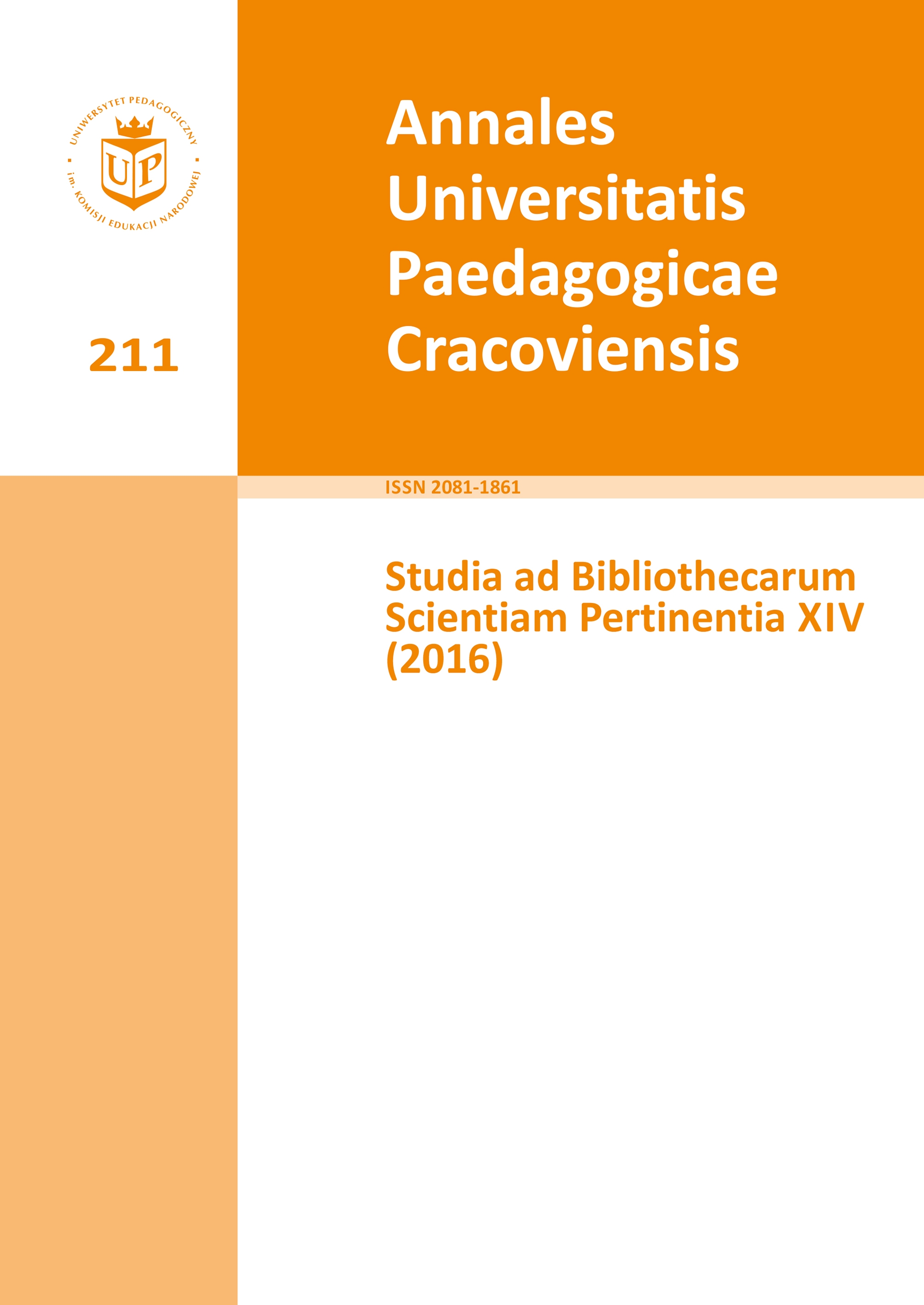The development of research on visualization of information
DOI:
https://doi.org/10.24917/20811861.14.4Keywords:
data visualization, maps, information, visual science-metrics, InfovisAbstract
The last decade has shown a rapid development of interdisciplinary research on visualization of information (Infovis). In bibliology, the first person to become interested in these methods was a pioneer of science-metrics, E. Garfield, who introduced the term “science-grams”. In creation of “science-grams”, or maps of science, are involved IT specialists and bibliologists, computer specialists and science specialists, as well as specialists on presentation of information and graphic designers. This article aims at presenting the possibilities of using Infovis as a new field of research in information sciences through a series of examples of visualization for the collection of metadata, that come with bibliographic descriptions of documents available in Polish digital libraries. The results of the analyzes of metadata the authors presented in graphical form, choosing the technique of visualization according to the data type (number, text, date) and according to context analysis. The targets of data visualization: detection of quantitative changes on a graph, showing the geographical spread of the data, the disclosure of intellectual and social relationships, and effective communication of the idea of the experiment, are described in detail and illustrated.
References
Börner K., The Atlas of Science, USA 2010.
Chen Ch, Information Visualization. Beyond the Horizon, 2nd ed, London 2006.
Chen Ch., Kuljis J., The rising landscape: a visual exploration of superstring revolutions in physics, “Journal of the American Societyfor Information Science and Technology”, 2003, 54(5), s. 435–446.
Garfield E., Historiographic mapping of knowledge domains literaturę, “Journal of Information Science” 2004, nr 30(2).
Garfield E., Pudovkin A.L., Istomin V.S., Why do we need algorithmic historiography?, “Journal of the American Society for Information Science and Technology”, 2003, nr 54(5), s. 400-412.
Garfield E., Scientography: Mapping the tracks of science. W: “Current Contents: Social & Behavioural Sciences”, 1994, nr 7(45).
Garfield E., Sher I.H., Torpie R.J., The Use of Citation Data in Writing the History of Science, Pensylvania, USA 1964.
Jóźwik K., Zwoliński Sz., Myślenie wizualne w biznesie. Ty też potrafisz rysować, Warszawa, 2015
Lima M., The Book of Trees. Visualizing Branches of Knowledge, New York, 2014.
Madsen R. E., Hansen L.K., Winther O., Singular value decomposition and principal component analysis, Raport techniczny 2004 [dostęp 30.06.2016]. Dostępny w World Wide Web: http://www2.imm.dtu.dk/pubdb/views/edoc_download.php/4000/pdf/imm4000.pdf
Malak P., Indeksowanie treści, Warszawa 2012.
Malak P., Pawłowski A., Ewaluacja skuteczności systemów wyszukiwania informacji. Od eksperymentu Cranfield do laboratoriów TREC i CLEF. Geneza, metody i wyniki, „Toruńskie Studia Bibliologiczne” 2015, nr 1 (14).
Miller G.A., The magical numer seven, plus or minus two: some limits of our capacity for processing information, “Psychological Review”, 2001, t. 101, nr 2, s. 343-352.
Osinska V., Osinski G., Kwiatkowska A.B., Visuallization in Learning: Perception, Aesthetics and Pragmatism, [w:] Maximizinq Coqnitive Learninq throuqh Knowledqe Visualization, red.
A. Ursyn, Hershey, PA 2015, R. 13.
Osińska V., Mapowanie nauki i potencjał analityczny tego procesu, „Zagadnienia Informacji Naukowej”, 2010, nr 2(96), s. 41-51.
Osińska V., Wizualizacja i wyszukiwanie dokumentów, Warszawa 2010.
Osińska V., Wizualizacja informacji. Studium informatologiczne, Toruń 2016.
Osińska V., Wizualizacja paradygmatów naukowych, “Zagadnienia naukoznawstwa”, 2012, nr 48, s. 205-220.
Stephen F., Now you see it. Simple Visualization techniques and Quantitative Analysis, CA, USA 2009.
Strang G., Introduction to linear algebra, 4th Edition, Cambridge, UK, 2009 [dostęp 30.06.2016]. Dostępny w World Wide Web: http://math.mit.edu/~gs/linearalgebra/.
Badania społeczeństwa informacyjnego, Portal Pinterest, [dostęp 30.06.2016] Dostępny w World Wide Web: https://pl.pinterest.com/veslavaosinska/badania-spo%C5%82ecze%C5%84stwa-informacyjnego/.
Clarin PL - Polska część infrastruktury naukowej CLARIN ERIC, [dostęp 30.06.2016]. Dostępny w World Wide Web: http://ws.clarin-pl.eu/demo2/tager.shtml.
Federacja Bibliotek Cyfrowych, [dostęp 30.06.2016]. Dostępny w World Wide Web: http://fbc.pionier.net.pl/.
GapMinder [dostęp 30.06.2016]. Dostępny w World Wide Web: https://www.gapminder.org/.
Garfield E., Essays/Papers on Mapping the World of Science, [dostęp 30.06.2016]. Dostępny w World Wide Web: http://garfield.library.upenn.edu/ mapping/mapping.html.
Graphical abstracts, Elsevier, [dostęp 30.06.2016] Dostępny w World Wide Web: http://www.elsevier.com/authors/journal-authors/graphical-abstract
Hyperbolic browser, WikiViz, [dostęp 30.06.2016]. Dostępny w World Wide Web: http://www.wikiviz.org/wiki/Hyperbolic_browser.
Kulczycki E., Post na blogu, [dostęp 30.06.2016]. Dostępny w World Wide Web: https://www.facebook.com/emanuelkulczycki?fref=ts.
Kulczycki E., Warsztat badacza – Emanuel Kulczycki, [dostęp 30.06.2016]. Dostępny w World Wide Web: http://ekulczycki.pl/
Leiden Manifest for Research Metrics, [dostęp 30.06.2016]. Dostępny w World Wide Web: http://www.nature.com/news/bibliometrics-the-leiden-manifesto-for-research-metrics-1.17351
Lengler R., Eppler M., Visualisation methods Periodic Table, 2007, [dostęp 30.07.2016]. Dostępny w World Wide Web: http://www.visual-literacy.org/periodic_table/ periodic_table.html
Madsen R. E., Hansen L.K., Winther O., Singular value decomposition and principal component analysis, Raport techniczny 2004, [dostęp 30.06.2016]. Dostępny w World Wide Web: http://www2.imm.dtu.dk/pubdb/views/edoc_download.php/4000/pdf/imm4000.pdf
Schabish J., The Graphic Continuum,[dostęp 30.06.2016]. Dostępny w World Wide Web: http://visual.ly/graphic-continuum
Strang G., Introduction to linear algebra, 4th Edition 2009, [dostęp 30.06.2016]. Dostępny w World Wide Web: http://math.mit.edu/~gs/linearalgebra/.
Walrus - Gallery: Visualization & Navigation, Center for Applied Internet Data Analysis, [dostęp 30.06.2016]. Dostępny w World Wide Web: https://www.caida.org/tools/visualization/walrus/gallery1.
Weingart S., Diagrams of knowledge, Blog 2013, [dostęp 30.06.2016]. Dostępny w World Wide Web: http://www.scottbot.net/HIAL/?page_id=39166
Wikipedia. Hasło Eugene Garfield, [dostęp 30.06.2016]. Dostępny w World Wide Web: https://en.wikipedia.org/wiki/Eugene_Garfield.
Wizualizacja informacji, [dostęp 30.07.2016]. Dostępny w World Wide Web: http://www.wizualizacjainformacji.pl/onas.php.
Downloads
Published
How to Cite
Issue
Section
License
Copyright (c) 2017 AUPC Studia ad Bibliothecarum Scientiam Pertinentia

This work is licensed under a Creative Commons Attribution 4.0 International License.

